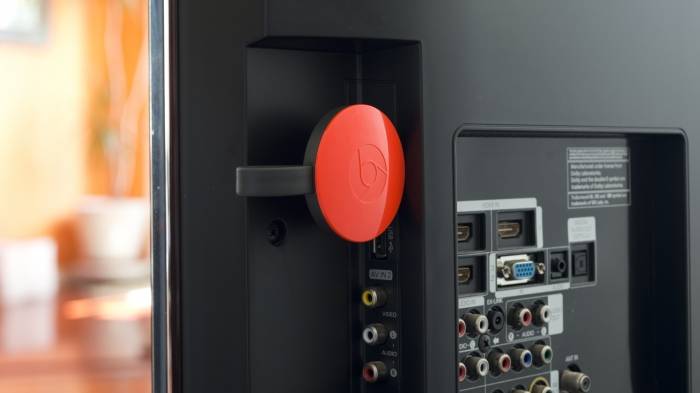

Update: The Chromecast app is getting a name change, Google announced earlier this week. In order to better align the name of the app with its functionality, it can now be found on both the iOS App Store and Google Play Store under the name Google Cast. According to a blog post, the name was changed to better represent the openness of the platform. Vizio announced Tuesday that it would offer a new series of TVs with Chromecast technology built directly into them, ditching a smart apps platform completely.
Original review below…
There wasn’t much the original Chromecast could improve upon – it was versatile, reliable, easy to set up and dirt cheap. But despite not having much room for improvement, somehow Google found a way to make a great product even better.
Had you asked me two months ago what the original was missing, I would have said that it needed a few more compatible apps to round out the catalog, and maybe a better app. But, considering its highly affordable sticker price, there wasn’t much to complain about.
But the first Chromecast’s successful design and sales meant two very important points for the new Chromecast.
First, because the original already worked so wonderfully, there’s little in the way of truly new features on Google’s latest streaming disc; by and large the biggest change is a cosmetic one. Chromecast has traded its stick format for something a little more pragmatic: a circular disc attached to an HDMI cable.
Secondly, expanding on the first point, because the original was so expertly crafted and priced below the competition, that means the market, at this point, is relatively well-saturated with these little gizmos.
It all raises the question: “why then, if the change is mostly cosmetic, should you buy a Chromecast 2?” The short and potentially not-so-sweet answer is that maybe you shouldn’t, unless you really don’t have anything better to spend $35 (£30, AU$49) on.
- See: Google Chromecast 2 vs Chromecast 1
Now, that said, for anyone who doesn’t already own one of these near-flawless, original streaming devices or can’t stand the buffering issues of the previous generation, I’m glad to report that the new Chromecast is easily the best streaming device at its price point.
But before we get into the nitty gritty details, let’s rehash the story of how the original stole our hearts.
Chromecast: what is it?
The idea behind the Chromecast was to bring smart functionality to the series of “dumb” TVs that hit the market before smart TVs rose to popularity near the end of the last decade.
Like the original, the new Chromecast plugs directly into your TV’s HDMI port (make sure it has one of those before you buy it) and streams video from your mobile phone, tablet or PC.
Here’s the odd part: it doesn’t have a remote or a user-interface per se. Google’s little streamer will sit there like an electronic canine waiting for your other devices to tell it what to do.
- Read: New Chromecast release date, news and features
It’s different in that way from its main competition – the Amazon Fire TV Stick and Roku Streaming Stick – the two devices that only came about after Chromecast’s debut. All of these devices can take streaming content from apps like Netflix, Sling TV, HBO Now and, in Amazon Fire TV’s case, Amazon Prime Video, and toss it onto your TV.
But more impressive than any individual external detail or snippet of code is its price. The new Chromecast only costs $35 (£30, AU$49), around $10 or £5 less than its closest competitor. At roughly the cost of two Blu-rays, it’s tough to turn down.
Chromecast vs. the competition
The Chromecast’s calling card is the ability to sync with your mobile phone, tablet and PC. Few devices work as seamlessly with your electronics as Chromecast does, and any that do require you to be bought into a particular family of products.
Chromecast vs. Amazon Fire TV and Fire TV Stick: Chromecast is by far the cheaper streaming stick and can outperform Amazon’s streaming device, thanks to its new-and-improved 802.11ac Wi-Fi antenna. Both Amazon products – $99 (£79, about AU$140) for the box and $39 (£35, about AU$56) for the stick – come with a remote, but also rely heavily on a subscription to Amazon Prime to function at their fullest potential.
That said, if you are an Amazon Prime subscriber you won’t be able to watch the service on Google’s streaming stick – Amazon’s mobile app doesn’t support Google Cast functionality.
Chromecast vs. Roku 3 and Roku Streaming Stick: Here’s a story of David and the Goliath. The circular Chromecast does much of what the $99 (£79, about AU$140) Roku 3 does, though it depends more on your phone, tablet and PC to keep pace. Roku is known for having thousands of channels of content and universal search functionality that allows you to search multiple sources at once.
Google has adopted the latter into the latest version of its Chromecast app, but doesn’t have near the amount of channels Roku has. If you’re looking for full-size streaming device with access to any and every streaming service, Roku can’t be beat. If you’re looking for a simplistic solution to putting audio and video on your TV, however, Chromecast is the way to go.
Chromecast vs. the new Apple TV: Apple TV, like Amazon’s streamer, favors its own ecosystem, at least in terms of hardware. On the software side of things, Apple opened up its app store to every developer for the first time in the history of its home entertainment device, making it a bit more well-rounded than the Chromecast. It also includes a new remote and an 802.11ac antenna, identical to the one found in the new Chromecast. That said, Apple TV costs a whopping $149 (about £96, AU$200).
[source :-in.techradar]





